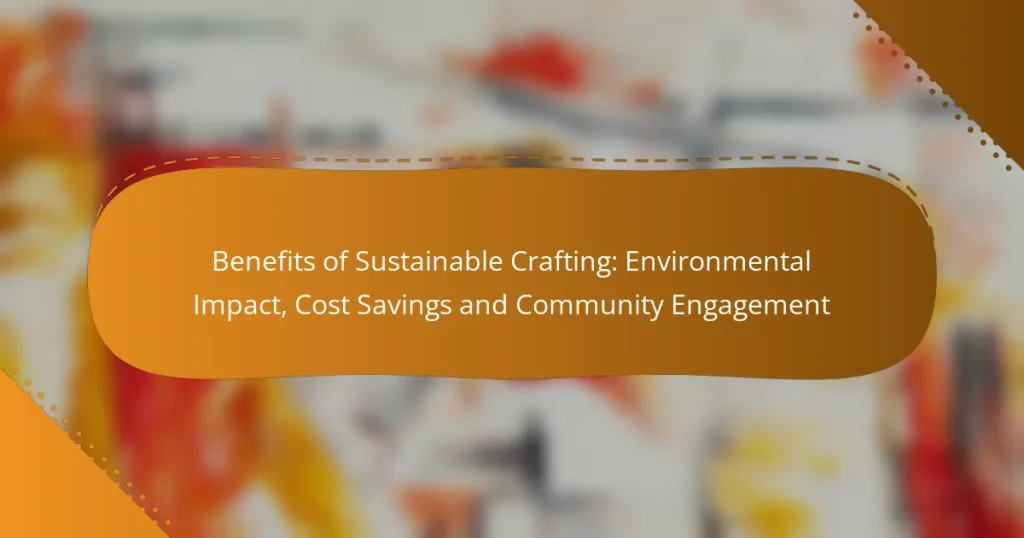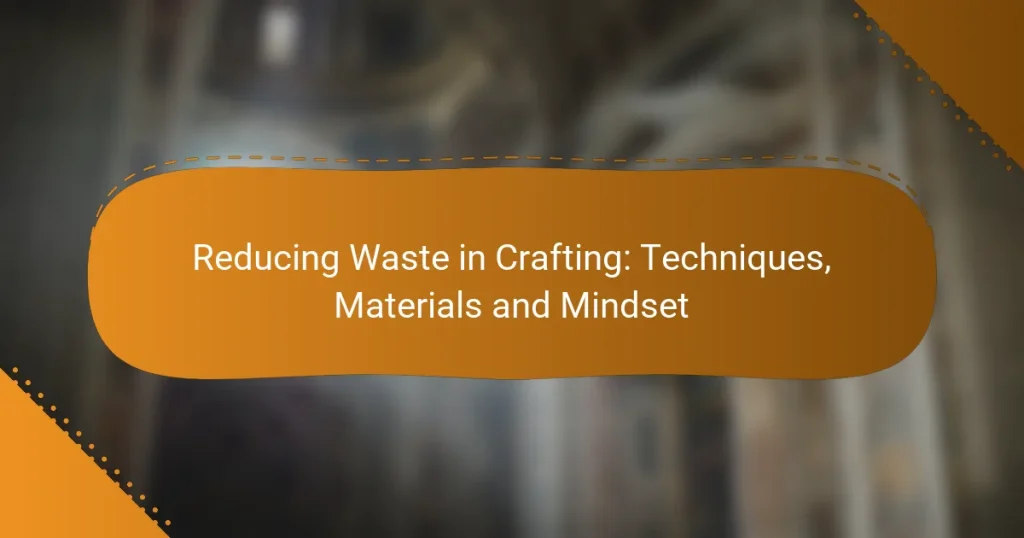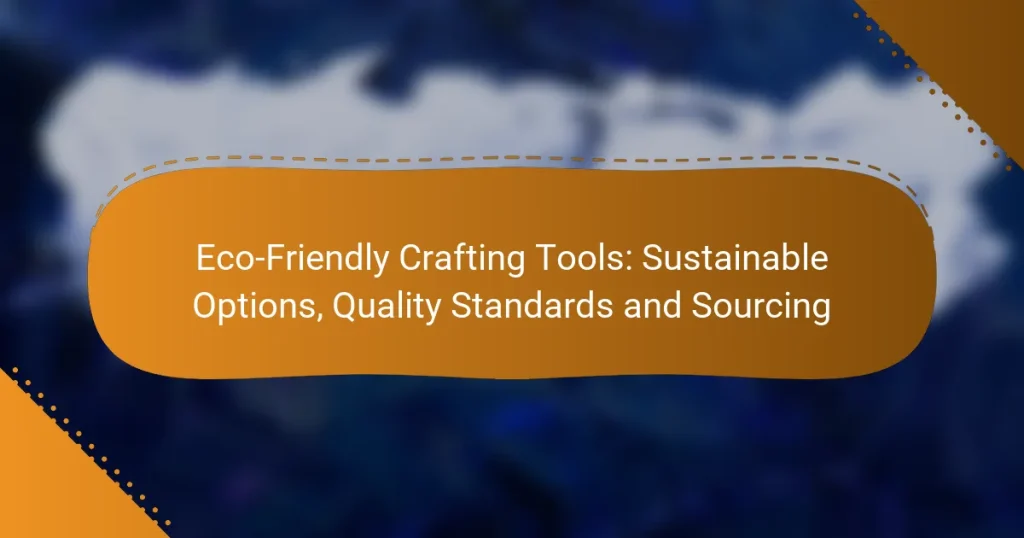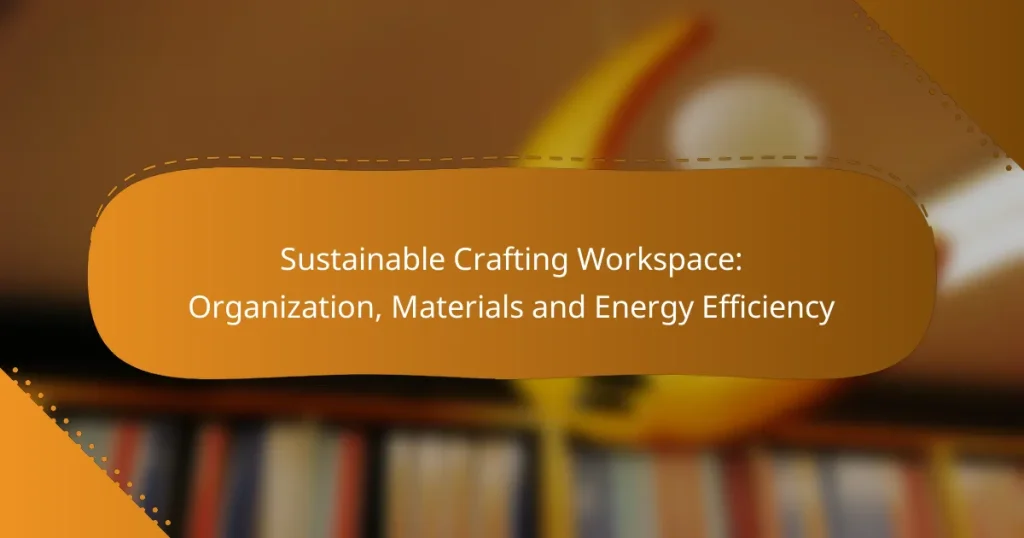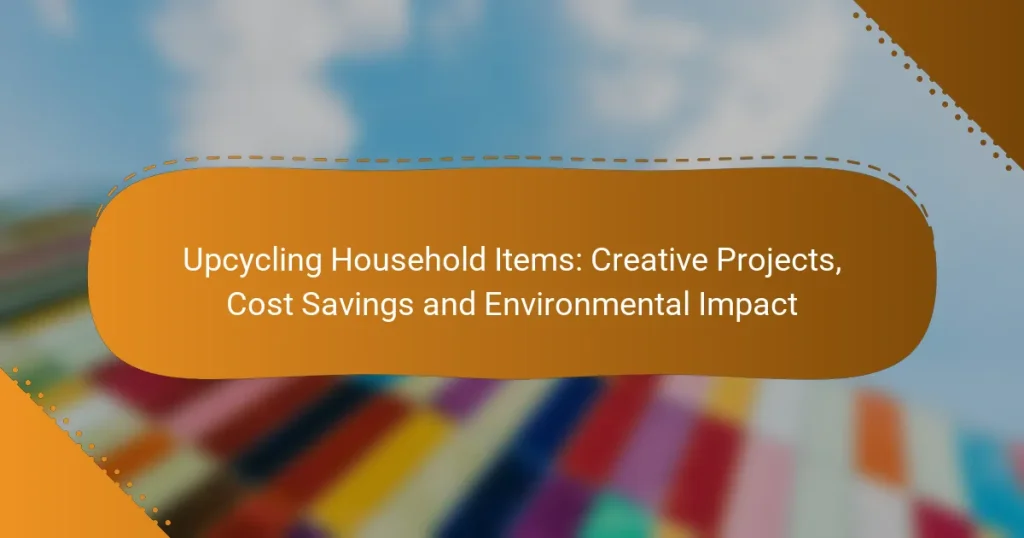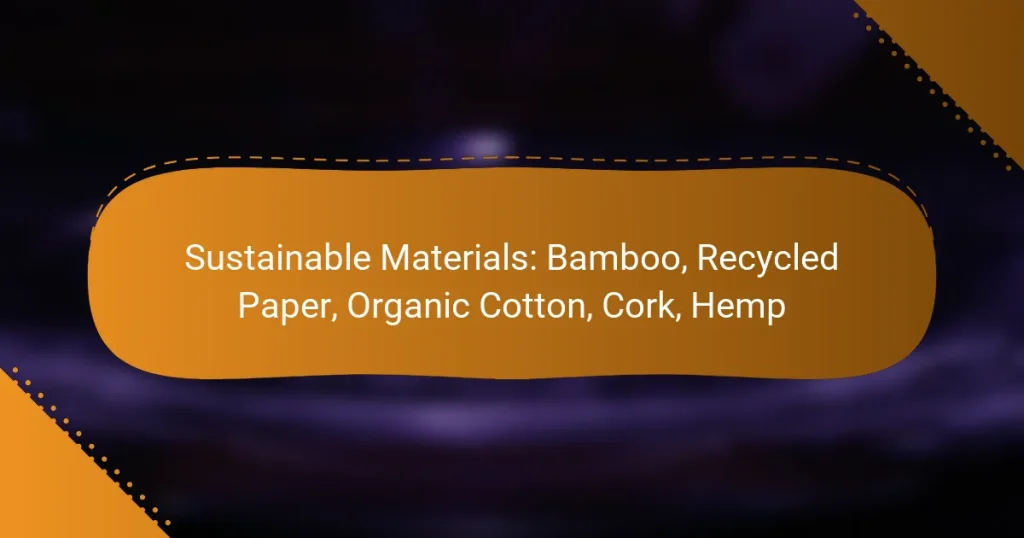Sustainable crafting practices emphasize the importance of reducing environmental impact while creating unique handmade items. By prioritizing eco-friendly materials and waste reduction, these practices foster a responsible approach to crafting that benefits both the planet and the creator. Embracing sustainability not only enhances creativity but also promotes community involvement and personal well-being.
Reducing Waste in Crafting: Techniques, Materials and Mindset
Eco-Friendly Crafting Tools: Sustainable Options, Quality Standards and Sourcing
Eco-Conscious Crafting Ideas: Kids’ Projects, Educational Value and Fun Activities
Sustainable Crafting Workspace: Organization, Materials and Energy Efficiency
Upcycling Household Items: Creative Projects, Cost Savings and Environmental Impact
Sustainable Materials: Bamboo, Recycled Paper, Organic Cotton, Cork, Hemp
What are sustainable crafting practices?
Sustainable crafting practices focus on minimizing environmental impact while creating handmade items. These practices prioritize eco-friendly materials, waste reduction, and community involvement to promote a more responsible approach to crafting.
Eco-friendly materials
Using eco-friendly materials is essential for sustainable crafting. This includes natural fibers like organic cotton, bamboo, and hemp, as well as recycled or upcycled materials. Choosing these options reduces reliance on synthetic substances that can harm the environment.
When selecting materials, consider their sourcing and lifecycle. Look for certifications such as Global Organic Textile Standard (GOTS) for textiles or Forest Stewardship Council (FSC) for wood products. These labels ensure that materials are sustainably harvested and processed.
Waste reduction techniques
Implementing waste reduction techniques is crucial for sustainable crafting. Start by planning your projects carefully to minimize leftover materials. Techniques such as zero-waste pattern making can help ensure that fabric scraps are utilized effectively.
Consider donating or repurposing any excess materials instead of discarding them. Local community centers or schools often welcome craft supplies for educational projects. This not only reduces waste but also fosters creativity in others.
Community engagement
Engaging with the community enhances the impact of sustainable crafting practices. Participate in local crafting groups or workshops that emphasize eco-friendly methods. This collaboration can lead to shared resources and knowledge, strengthening community bonds.
Additionally, consider organizing or joining events like craft fairs that promote sustainable products. These gatherings raise awareness and encourage others to adopt sustainable practices, creating a ripple effect in your community.
How can I start sustainable crafting?
To start sustainable crafting, focus on using eco-friendly materials and minimizing waste in your projects. This approach not only benefits the environment but also enhances the creativity and uniqueness of your crafts.
Choosing sustainable supplies
Selecting sustainable supplies is crucial for eco-friendly crafting. Look for materials that are renewable, recycled, or biodegradable. For instance, organic cotton, bamboo, and recycled paper are excellent choices that reduce environmental impact.
When purchasing supplies, consider local options to minimize transportation emissions. Local artisans and craft stores often offer sustainable products that support the community and reduce carbon footprints.
Implementing recycling methods
Incorporating recycling methods into your crafting routine can significantly reduce waste. Start by repurposing materials from old projects or household items, such as glass jars, fabric scraps, and cardboard boxes. This not only saves money but also sparks creativity.
Establish a system for sorting and storing recyclable materials. Keep bins for different types of materials, making it easier to access them for future projects. Additionally, consider organizing community swaps or donation drives to share excess supplies with fellow crafters.
What are the benefits of sustainable crafting?
Sustainable crafting offers numerous advantages, including reduced environmental impact, cost savings, and improved health. By using eco-friendly materials and practices, crafters can create beautiful items while minimizing harm to the planet and their well-being.
Environmental impact
Sustainable crafting significantly lowers the environmental footprint associated with traditional crafting methods. By opting for recycled or biodegradable materials, crafters help reduce waste and conserve natural resources. For example, using reclaimed wood or organic cotton can prevent deforestation and decrease pollution.
Additionally, sustainable practices often involve using non-toxic adhesives and paints, which contribute to cleaner air and water. This not only benefits the environment but also supports biodiversity by protecting ecosystems from harmful chemicals.
Cost savings
Engaging in sustainable crafting can lead to substantial cost savings over time. By utilizing materials that are locally sourced or repurposed, crafters can often reduce their expenses. For instance, sourcing second-hand supplies from thrift stores or community exchanges can be significantly cheaper than purchasing new materials.
Moreover, sustainable crafting encourages creativity and resourcefulness, allowing individuals to create unique items without breaking the bank. Investing in quality, durable materials can also save money in the long run, as these items typically require less frequent replacement.
Health benefits
Choosing sustainable crafting materials can have positive effects on health. Many conventional crafting supplies contain harmful chemicals that can lead to respiratory issues or skin irritations. By selecting non-toxic, natural alternatives, crafters can create a safer crafting environment.
Furthermore, sustainable crafting often promotes mindfulness and well-being, as the process of creating can be therapeutic. Engaging in hands-on activities has been shown to reduce stress and enhance mental health, making crafting not just an enjoyable hobby but also a beneficial practice for overall wellness.
What tools are essential for sustainable crafting?
Essential tools for sustainable crafting include eco-friendly adhesives, biodegradable paints, and recycled crafting tools. These items not only minimize environmental impact but also support a more responsible approach to creativity.
Eco-friendly adhesives
Eco-friendly adhesives are designed to reduce harmful emissions and environmental damage. Look for options that are water-based, non-toxic, and made from renewable resources. Common choices include PVA glue, plant-based glues, and natural rubber adhesives.
When selecting an adhesive, consider its drying time and bond strength. Some eco-friendly options may take longer to set compared to traditional adhesives, so plan your projects accordingly. Always check for certifications like Green Seal or EcoLogo to ensure you’re choosing a truly sustainable product.
Biodegradable paints
Biodegradable paints are made from natural ingredients that break down safely in the environment. These paints often contain fewer volatile organic compounds (VOCs), making them a healthier choice for both crafters and the planet. Look for brands that specify their biodegradability on the label.
When using biodegradable paints, be mindful of their application methods. They may require different techniques compared to conventional paints, such as using natural brushes or sponges. Always test on a small area first to ensure compatibility with your materials.
Recycled crafting tools
Recycled crafting tools are made from repurposed materials, reducing waste and conserving resources. Items like scissors, rulers, and cutting mats can often be found made from recycled plastics or metals. Purchasing these tools supports a circular economy and encourages sustainable manufacturing practices.
To find recycled crafting tools, check local craft stores or online marketplaces that specialize in eco-friendly products. Be sure to verify the percentage of recycled content and look for certifications that indicate sustainable sourcing. This not only benefits the environment but often adds a unique character to your crafting projects.
How to find sustainable crafting communities in the US?
To find sustainable crafting communities in the US, explore local workshops and online forums dedicated to eco-friendly practices. These platforms offer opportunities to connect with like-minded individuals and share resources for sustainable crafting.
Local workshops
Local workshops are an excellent way to engage with sustainable crafting communities. Look for events at community centers, craft stores, or eco-friendly organizations that focus on sustainable techniques and materials. Participating in these workshops can provide hands-on experience and foster connections with local artisans.
Many cities host regular crafting events, such as “upcycling” workshops where participants learn to repurpose materials. Check local event listings or social media groups to find upcoming sessions. Engaging in these activities not only enhances your skills but also supports local economies.
Online forums
Online forums are a valuable resource for finding sustainable crafting communities across the US. Websites like Reddit, Facebook groups, and specialized crafting forums allow users to share tips, resources, and project ideas. These platforms can connect you with a wider audience interested in sustainable practices.
When joining online forums, consider participating in discussions about sustainable materials and techniques. Look for threads that focus on eco-friendly crafting, and don’t hesitate to ask questions or share your own experiences. This engagement can lead to valuable insights and collaborations with fellow crafters.
What are some innovative sustainable crafting ideas?
Innovative sustainable crafting ideas focus on using eco-friendly materials and techniques that minimize environmental impact. These practices often involve repurposing items, utilizing natural resources, and reducing waste in the crafting process.
Upcycling Materials
Upcycling involves transforming waste materials into new products that have value. For example, old glass jars can be converted into decorative candle holders or storage containers. This practice not only reduces landfill waste but also encourages creativity and resourcefulness.
When considering upcycling, look for items that are durable and can be easily cleaned or modified. Common materials include fabric scraps, wood pallets, and plastic containers. The key is to envision new uses for these items rather than discarding them.
Natural Dyes and Inks
Using natural dyes and inks derived from plants, fruits, and vegetables is a sustainable alternative to synthetic options. For instance, beet juice can create a vibrant red dye, while turmeric yields a bright yellow. These natural options are often safer for both the environment and the crafter.
To get started, gather materials like onion skins, avocado pits, or coffee grounds. Experiment with different mordants, such as vinegar or salt, to enhance color retention. Remember to test your dyes on small fabric samples before committing to larger projects.
Eco-Friendly Tools
Selecting eco-friendly tools can significantly reduce the environmental footprint of your crafting activities. Look for tools made from sustainable materials, such as bamboo or recycled metals. These options tend to be more durable and often come from manufacturers committed to sustainable practices.
Additionally, consider investing in high-quality tools that will last longer, reducing the need for frequent replacements. Avoid single-use plastic tools and opt for multi-functional items that can serve various purposes in your crafting projects.
